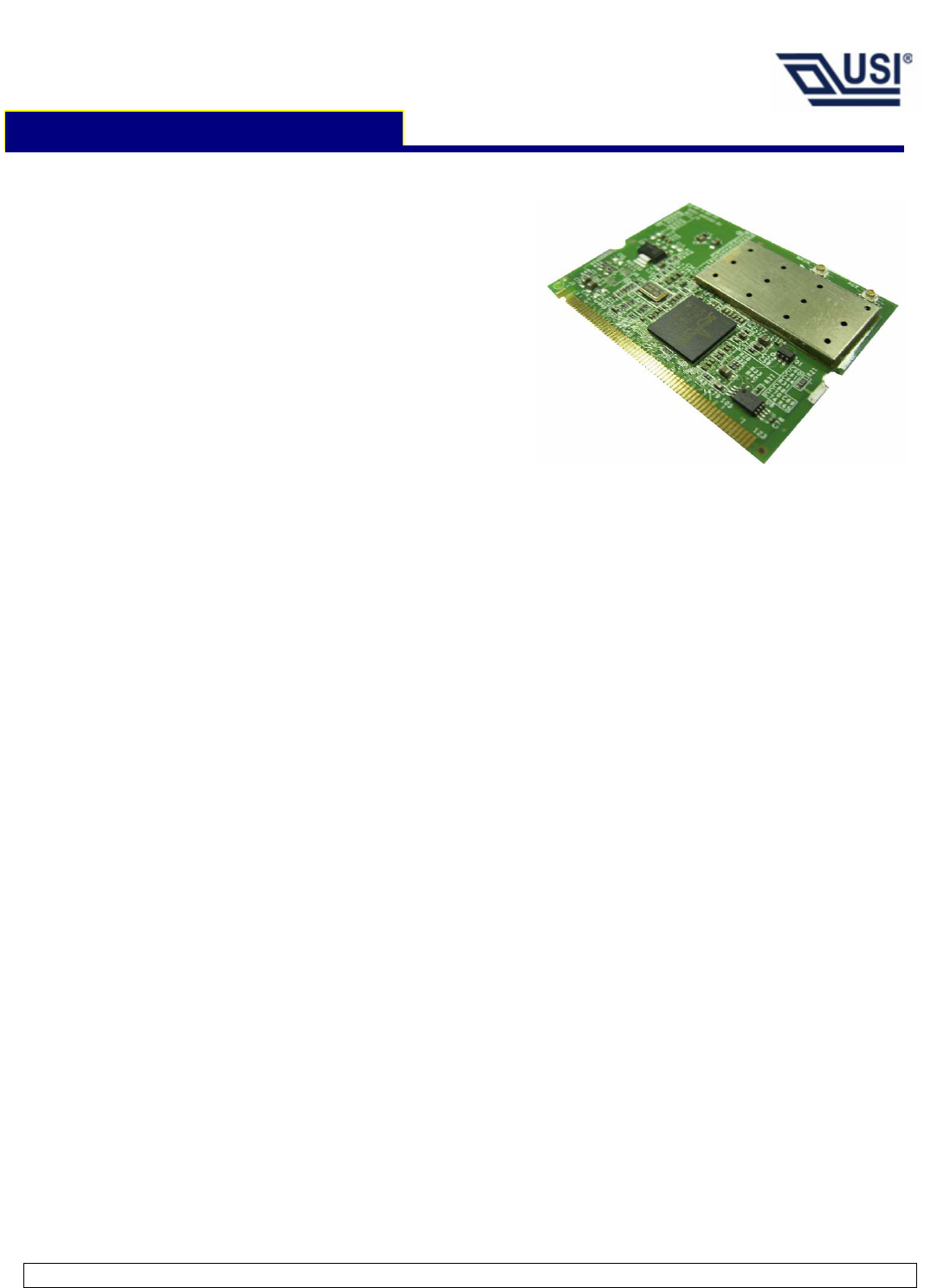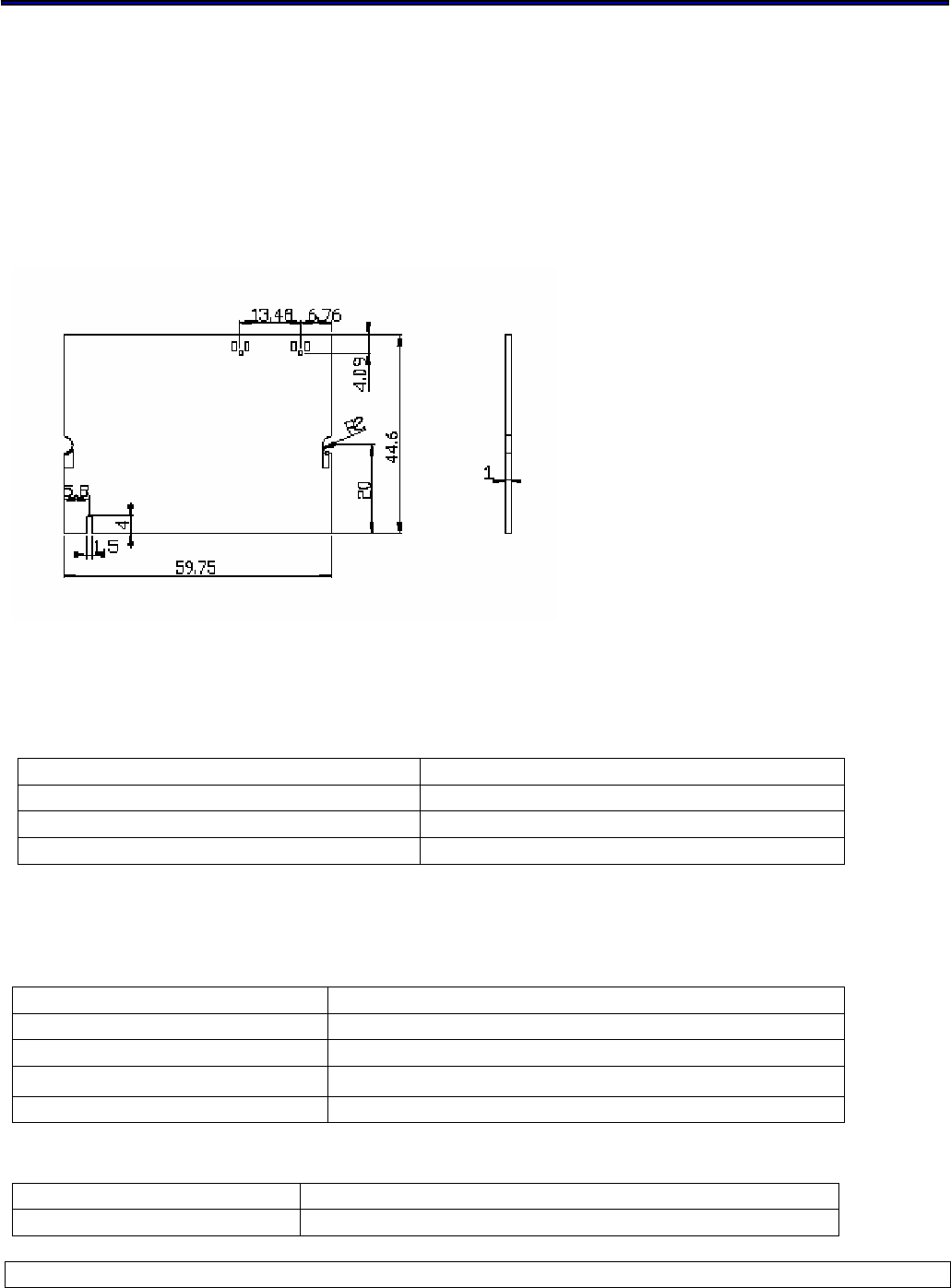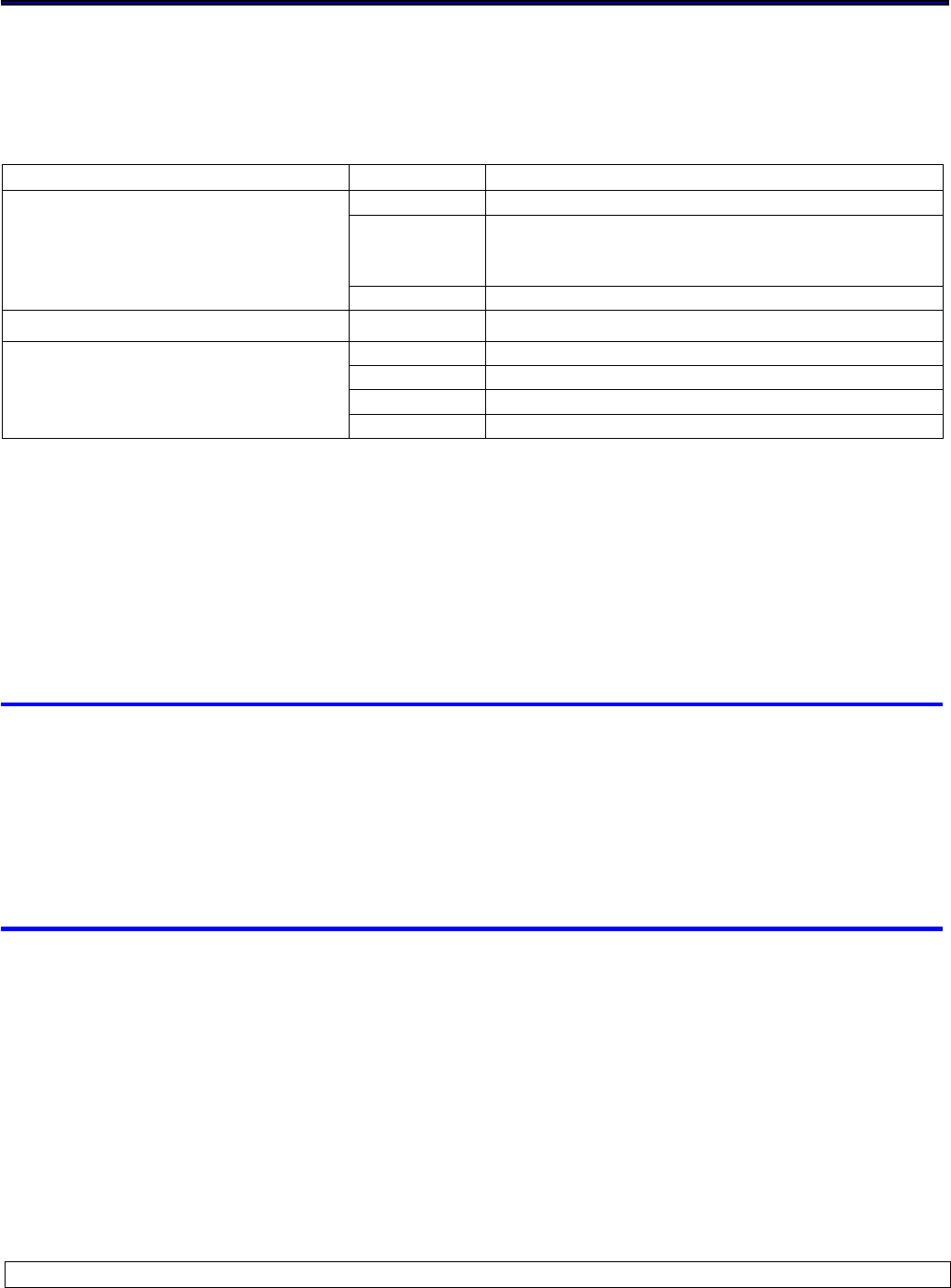Universal Scientific MPGBR05 802.11b/g Mini-PCI Module User Manual
Universal Scientific Industrial Co., Ltd. 802.11b/g Mini-PCI Module Users Manual
Users Manual

All rights are reserved by USI. No part of this technical document can be reproduced in any form without permission of USI.
MP-G-BR-05
802.11G WIRELESS LAN MINI PCI ADAPTER
Data Sheet Nov. 2004 Rev 1.6 www.usi.com.tw
Features
• Automatic fallback: 54 Mbit/s, 48 Mbit/s, 36
Mbit/s, 24 Mbit/s, 18 Mbit/s, 12 Mbit/s, 11
Mbit/s, 9 Mbit/s, 6 Mbit/s, 5.5 Mbits/s, 2
Mbits/s, or 1 Mbit/s .
• Advanced silicon breakthrough single chip
solution with Encore technology in this
product which gain the advantage to better
resistance to multipath; improve Rx
sensitivity by enhanced DSP processing
and adaptive equalization algorithms.
• Feature with Afterburner technology for this
54g platform, Products with this new
technology provide up to 40 percent
greater throughput than typical standard
802.11g systems without impacting the
performance of neighboring wireless LANs.
• Low power consumption & Automatic
power management to reduce battery use.
• Easy integration into mobile and hand-held
platforms. It’s flexible for design and
antenna placement.
• External antenna diversity.
• Support AES-CCM, WPA (SSN-TKIP), and
WEP (64-bit/128-bit or 152-bit).
• Corresponding to IEEE
802.11b/gspecification.
• Interoperable with other IEEE
802.11a/b/gcompliant systems.
• Conformable to industry-standard Mini-PCI
Card Type III-B specification.
• Support Windows 98SE/ME/2K/XP,Linux,
Introduction
The Mini-PCI Adapter type-III B is a high-speed
54 Mbits/s wireless networking card providing a
multimode 802.11 b/g or 11g mode only
connectivity for enterprise and home wireless
LAN access.
The Mini-PCI Card uses direct sequence
spread spectrum (DSSS), Orthogonal
Frequency Division Multiplexing (OFDM)
technology, and implements DBPSK, DQPSK,
and CCK, OFDM modulation, as defined in the
IEEE® 802.11b, g. This gives a very robust
radio channel, which is made even better by the
excellent receiver sensitivity and delay spread
robustness.
In environments with radio interference, the
Mini-PCI Card, because of its acknowledgment
protocol and its option to be tuned to another
frequency channel, continues to run.
Superior echo path management makes it
suitable for areas with a large delay spread, for
example, warehouses. This reduces the
number of cells required and, therefore,
reduces the total cost of ownership.
A firmware-based architecture is capable of
supporting the latest industry standards in the
security and quality of service (QoS), as the
draft 802.11i and 802.11e standards,
respectively.
The Mini-PCI Card is complemented by drivers
and networking tools for various versions of the
Windows® operating system. USI provides
extensive technical documentation on
integration issues such as antenna design,
customizing drivers, and management
software.

802.11 b/g Wireless LAN Mini-PCI Adapter
All rights are reserved by USI. No part of this technical document can be reproduced in any form without permission of USI.
Physical Dimension/Packaging
The Mini-PCI Card has been designed to conform to the Mini-PCI specification, as defined in
Mini-PCI Specification Rev 0.1.
All dimensions in this section have a tolerance as permitted in the Mini-PCI Specification.
Dimension: 59.8 mm x 44.8 mm x 5.0 mm
Weight: Less than 25 g
Package: Bulk in 200 pcs.
Figure 1. Mini-PCI Type III-B dimension
Mechanically unique coaxial connectors for two external antennas.
Operating Conditions
Operating Temperature 0° to 70° Celsius
Operating Humidity 90% (non-condensing)
Storage Temperature -20°C to +75°C ambient temperature
Storage Humidity 95% (non-condensing)
Voltage and Current
The MP-G-BR-05 will comply with the following features and standards
Voltage 3.3 VDC from host (+/-0.2V)
Current 802.11g (Typ.)
Transmit <450mA
Receive <350mA
Stand By <50mA
Wireless Specification
The MP-G-BR-05 will comply with the following features and standards:
Features Description
WLAN Standards IEEE 802 Part 11b/g

802.11 b/g Wireless LAN Mini-PCI Adapter
All rights are reserved by USI. No part of this technical document can be reproduced in any form without permission of USI.
Antenna Connector Hirose connector supported with diversity
Data Rates 1, 2, 5.5, 11 Mbps for 802.11b
6, 9, 12, 18, 24, 36, 48, 54 Mbps for 802.11g and
125Mbps for AfterBunrer
Medium Access Protocol CSMA/CA (Collision Avoidance) with ACK
RF specification
Features Description
Frequency Band 2.412 – 2.497 GHz (2.4 GHz ISM Band)
Number of Channels 14 Channels
Modulation DBPSK, DQPSK, CCK DSSS for 802.11b & g
DPSK, QPSK, 16QAM, 64QAM OFDM for 802.11
g
Supported Rates 1, 2, 5.5, 11 Mbps for 802.11b
6, 9, 12, 18, 24, 36, 48, 54 Mbps for 802.11g
Maximum Receive Level -20dBm (with PER< 10%) for 802.11g
Antenna External (Hirose U-F-L)
Max. Output Power
19 dBm for 11b
15 dBm for 11g
Note: Actual output power may vary based on manufacturing process variations
802.11g Receive Sensitivity
Data Rates Receive Sensitivity
54 Mbps -72 dBm (typ)
11 Mbps -87dBm (typ.)
6 Mbps -88 dBm (typ.)
1 Mbps -95 dBm (typ.)
Note: Actual receive sensitivity for individual products may vary based on manufacturing
process and environmental variations
Antenna Specifications
The Mini-PCI adapter is available in two variants: unique coax connectors with diversity
function.
On-Board Diversity Switch
This variant of the Mini-PCI Card has connectors for two external passive antennas: MAIN and
AUX. One of the antennas is used for transmission, and the DSP selects which of the two to
use for reception, based on signal strength.

802.11 b/g Wireless LAN Mini-PCI Adapter
All rights are reserved by USI. No part of this technical document can be reproduced in any form without permission of USI.
The coax connectors for the antennas are mechanically unique, so that no off-the-shelf
connector will fit (FCC requirement).
Switch electronics for selection between the two antennas for reception of the stronger receive
signal is provided onboard.
Security
At the physical layer, transmissions are encrypted using WEP; three levels of encryption are
possible:
• 40-bit key plus 24-bit initialization vector
• 104-bit key plus 24-bit initialization vector
• 128-bit key plus 24-bit initialization vector
AES, TKIP, WPA draft 802.11i are supported.
Attacks have been made on WEP by exploiting various weaknesses. The Mini-PCI Card
implements random setting of the initialization vector and utilizes WEPplus, which prevents
initialization vectors that result in weak keys being used. WEPplus is completely compatible
with WEP.
For those operating systems that support it either natively or with an add-on supplement (i.e,
Windows 98, Windows 98SE, Windows ME, Windows 2000, Windows XP, the 802.1x,
WPA/TKIP SSN security standard are implemented. This offers port-based network access
control, and automatic key distribution.
Performance
Table 1. Characteristics at Different Rates
The real operating range will be different by measurement environment and condition.
802.11b/g
Data Rates Operating Distance
54 Mbps 70m
11 Mbps 370m
6 Mbps 330m
1 Mbps 550 m
International Channel Frequencies
The Mini-PCI Card uses frequencies in the 2.4 GHz to 2.5 GHz ISM band, as defined by IEEE
802.11.
The channels available in the regional variants of the Mini-PCI Card are:
• FCC: 1 to 11
• ETSI: 1 to 13
• Japan: 1 to 14

802.11 b/g Wireless LAN Mini-PCI Adapter
All rights are reserved by USI. No part of this technical document can be reproduced in any form without permission of USI.
Regulatory Body Approvals/Compliance
USI will perform pre-test for the following international regulations: approval is a matter for the
OEM once the device is integrated into a host platform.
Description Country Compliance
USA FCC CFR47 Part 15B, Class II
Europe 89/336/EEC, ETS 301 489-1&17 (2.4GHz)
EN61000-3-2 (Harmonic AC Current emissions)
EN55022 Class II, EN50082-1 (Immunity)
Electromagnetic Compatibility
Product safety International CB (IEC 60950)
USA FCC CFR47 part 15 C, para 15.247,295,209
Europe EN 300-328
Radio Regulations
Ordering Information
USI 802.11g miniPCI Adapter Model No. MP-G-BR-05
Rev: May 2004. Specifications are subject to change without notice.
IEC is a registered trademark of The Electrotechnical Commission.
IEEE is a registered trademark of The Institute of Electrical and Electronics Engineers, Inc.
Intel is a registered trademark of Intel Corporation
Microsoft, Windows, and Windows NT are registered trademarks and Windows Me and Windows XP are
trademarks of Microsoft Corporation.
For Additional information, please contact the following:
Universal Scientific Industrial Co., Ltd.
Headquarters
141, Lane 351, Taiping Road, Sec. 1 , Tsao-Tuen , Taiwan,
Http://www.usi.com.tw
Tel: + 886-49-2350876, 2325876
Fax: +886-49-3439561, 2337360,2351093
E-mail:usi@ms.usi.com.tw

Taiwan DGT warning statement
Translation:
Article 14
Without permission granted, the frequency change, transmitting power enhance or alter of
original design characteristic as well as function by company, enterprise, or user for approved
Low-power radio frequency devices is not allowed.
Article 17
Low-power radio-frequency devices shall not influence aircraft security and interfere legal
communications; If found, shall cease operating immediately until no interference is achieved.
Above mentioned Legal Communications is defined as radio communications operation follows
Telecommunications Act. Low-power radio-frequency devices must susceptible with the
interference from legal communications, ISM radio wave radiated devices.
Regulatory Statements for BCM94318MPG
USA-Federal Communications Commission (FCC)
This equipment has been tested and found to comply with the limits for a Class B digital device,
pursuant to Part 15 of FCC Rules. These limits are designed to provide reasonable protection
against harmful interference in a residential installation. This equipment generates, uses, and can
radiate radio frequency energy. If not installed and used in accordance with the instructions, it
may cause harmful interference to radio communications. However, there is no guarantee that
interference will not occur in a particular installation.
If this equipment does cause harmful interference to radio or television reception, which can be
determined by tuning the equipment off and on, the user is encouraged to try and correct the
interference by one or more of the following measures:
-Reorient or relocate the receiving antenna
-Increase the distance between the equipment and the receiver.
-Connect the equipment to outlet on a circuit different from that to which the receiver is
connected.
-Consult the dealer or an experienced radio/TV technician for help.
Any changes or modifications not expressly approved by the party responsible for compliance
could void the user’s authority to operate the equipment.
Caution: Exposure to Radio Frequency Radiation.
To comply with FCC RF exposure compliance requirements, a separation distance of at least 20 cm must
be maintained between the antenna of this device and all persons. This device must not be co-located or
operating in conjunction with any other antenna or transmitter.
Canada – Industry Canada (IC)
This device complies with RSS 210 of Industry Canada.
Operation is subject to the following two conditions: (1) this device may not cause interference,
and (2) this device must accept any interference, including interference that may cause undesired
operation of this device.”
L ‘ utilisation de ce dispositif est autorisée seulement aux conditions suivantes : (1) il ne doit pas
produire de brouillage et (2) l’ utilisateur du dispositif doit étre prêt à accepter tout brouillage
radioélectrique reçu, même si ce brouillage est susceptible de compromettre le fonctionnement
du dispositif.
The term "IC" before the equipment certification number only signifies that the Industry Canada
technical specifications were met.
To reduce potential radio interference to other users, the antenna type and its gain should be so
chosen that the equivalent isotropically radiated power (EIRP) is not more than that required for
successful communication.
To prevent radio interference to the licensed service, this device is intended to be operated
indoors and away from windows to provide maximum shielding. Equipment (or its transmit
antenna) that is installed outdoors is subject to licensing.
Pour empecher que cet appareil cause du brouillage au service faisant l'objet d'une licence, il doit
etre utilize a l'interieur et devrait etre place loin des fenetres afin de Fournier un ecram de
blindage maximal. Si le matriel (ou son antenne d'emission) est installe a l'exterieur, il doit faire
l'objet d'une licence.
Caution: Exposure to Radio Frequency Radiation.
The installer of this radio equipment must ensure that the antenna is located or pointed such that
it does not emit RF field in excess of Health Canada limits for the general population; consult
Safety Code 6, obtainable from Health Canada’s website www.hc-sc.gc.ca/rpb.
FCC Statements:
1. This device complies with Part 15 of the FCC rules. Operation is subject to the
following two conditions:
(1) This device may not cause harmful interference, and
(2) This device must accept any interference received, including interference
that may cause undesired operation.
2. This device and its antenna(s) must not be co-located or operating in conjunction
with any other antenna or transmitter.
3. Changes or modifications to this unit not expressly approved by the party
responsible for compliance could void the user authority to operate the equipment.
4. This device is for OEM installation only, the End User manual shall not contain
informationabout how to install the module.
5. This compliance to FCC radiation exposure limits for an uncontrolled environment,
and minimum of 20 cm separation between antenna and body.
6. Only the type of antenna tested may be used.
7. The end product must carry a label stating "Contains TX FCC ID:IXMMPGBR05 ".